Titans Of Swing

The Swing Era, a period of unparalleled innovation in jazz, gifted the world with music that transcends time. It was a time when legends like Fletcher Henderson, Duke Ellington, and Benny Goodman took the stage, blending intricate arrangements with the soulful rhythms of jazz. These titans of swing were not just musicians; they were architects of a new sound that captivated the hearts and feet of an entire generation. Their legacy is not merely in the notes they played but in the spirit of innovation and unity they fostered through their music.
As we reflect on the contributions of these extraordinary artists, we are reminded of the enduring power of swing music to bring people together. The “Titans of Swing” were pioneers who charted new territories in jazz, leaving behind a treasure trove of melodies that continue to inspire and delight. Their music was a beacon of joy during tumultuous times, and today, it remains a testament to their genius, creativity, and the timeless appeal of swing. The legacy of the swing era is a melody that plays on, echoing through the ages and inviting us to dance once more to the rhythms of history.
The Bastions Of Big Band Bosses
Fletcher Henderson: The Architect of Swing
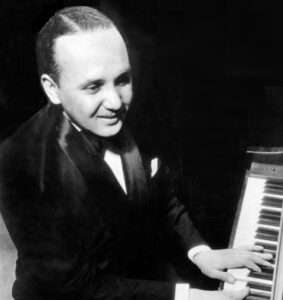
Fletcher Henderson, an accomplished pianist and bandleader, was instrumental in the development of swing music. Born in 1897, Henderson’s career spanned several pivotal eras in jazz, but it was his work in the 1920s and 1930s that cemented his legacy. As the leader of his own band, Henderson fostered a sound that was a precursor to the Swing Era, blending the structured arrangements of big band music with the improvisational flair of jazz.
His arrangements were innovative and often complex, pushing the boundaries of what was musically possible at the time. These arrangements became the foundation for swing music, influencing countless musicians and bandleaders, including Benny Goodman, for whom Henderson later arranged. This cross-pollination of ideas helped define the sound of the Swing Era, with Henderson’s influence reaching far and wide through the music of the bands that adopted his style.
Despite facing racial barriers and financial difficulties, Henderson persevered, and his arrangements helped to shape the sound of the Swing Era. His orchestra was a training ground for many jazz greats, and his ability to bridge the gap between the Dixieland and swing styles allowed for a smoother transition into the era of big band jazz.
Henderson’s partnership with Goodman in the 1930s brought his arrangements into the mainstream, as they were played by Goodman’s band and broadcast nationwide. This exposure was pivotal in popularizing swing music and bringing it into American homes. Fletcher Henderson’s vision and innovation laid the groundwork for swing music, and his arrangements remain a testament to his genius and his contribution to the art form.
Duke Ellington: Jazz Royalty and His Orchestra
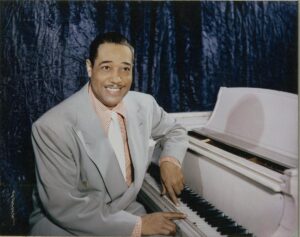
Edward Kennedy “Duke” Ellington stands as one of the most influential American composers, pianists, and bandleaders in the history of jazz music. His orchestral soundscape was vast, spanning beyond the swing era to include blues, gospel, and classical elements, creating a unique, sophisticated genre of its own. Duke Ellington’s orchestra, renowned from the late 1920s through the post-war era, was a crucible for musical talent, fostering many jazz legends and introducing a wider audience to the sounds of jazz.
Ellington’s specific contributions to the swing era were monumental, as he developed a new language within jazz composition and arrangement. Rather than focusing solely on the dance-driven swing style, he infused his music with lyrical complexity and emotional depth, often characterized by a conversational interplay between instrumental sections. His compositions, such as “It Don’t Mean a Thing (If It Ain’t Got That Swing)” and “Mood Indigo,” were not only staples of the swing repertoire but also stood as testament to his innovative spirit.
Moreover, Ellington used his platform to address social and political issues, subtly weaving messages of social justice into his music. This was most notably seen in his extended jazz works, which combined the vigor of big band swing with the narrative power of African-American spirituals and the blues, reflecting the struggles and triumphs of the African-American experience.
Throughout his prolific career, Ellington’s influence extended beyond his compositions. As a bandleader, his orchestra was among the top ensembles, attracting and nurturing talent that would define jazz for decades to come. His legacy is a testament to his vision and artistry, cementing him not just as a figure of the swing era, but as a timeless icon of American music.
Benny Goodman: The King of Swing
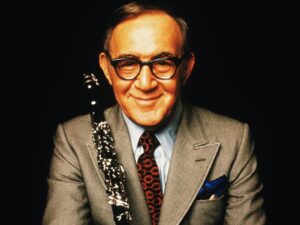
Benjamin “Benny” David Goodman, born on May 30, 1909, in Chicago, Illinois, rose from modest beginnings to become a legendary figure in jazz history. Known as the “King of Swing,” Goodman’s virtuosic clarinet playing and his leadership of one of the most popular big bands of the Swing Era not only earned him a royal nickname but also played a pivotal role in bringing jazz to mainstream audiences. His early life, steeped in the rich musical culture of Chicago, provided the foundation for a career that would revolutionize American music.
Goodman’s breakthrough came in the early 1930s, a period marked by the Great Depression, when his unique blend of jazz and swing brought hope and joy to a beleaguered nation. Through radio broadcasts and recordings, his orchestra reached millions, popularizing swing music and setting the stage for the Swing Era. Goodman’s insistence on musical excellence and his innovative arrangements attracted some of the finest musicians of the time, contributing to the band’s unprecedented success.
Perhaps Goodman’s most significant contribution to music and society was his pioneering stance on racial integration. At a time when segregation was rampant, Goodman hired African American musicians, making his band one of the first integrated orchestras. This bold move not only challenged societal norms but also set a precedent for future generations of musicians. His famous 1938 concert at Carnegie Hall, considered one of the most important live jazz concerts ever, showcased the talents of both white and black musicians, breaking cultural barriers and cementing his legacy as a force for change.
Goodman’s influence extended beyond his social impact; his mastery of the clarinet set new standards for the instrument, inspiring countless musicians. His technical prowess and emotive playing style brought a new level of artistry to jazz, elevating the clarinet to a lead instrument in big band arrangements. His recordings from the Swing Era remain essential listening for anyone interested in jazz, offering a window into the creative vitality of the period.
Benny Goodman’s death on June 13, 1986, marked the end of an era, but his legacy endures. As the “King of Swing,” Goodman’s contributions went beyond music; he played a key role in the cultural shift of the 20th century, bringing people together through the universal language of music. His pioneering spirit, both musically and socially, leaves an indelible mark on the history of American music, ensuring his place as one of the most influential musicians of his time.
Count Basie: The Count of Swing
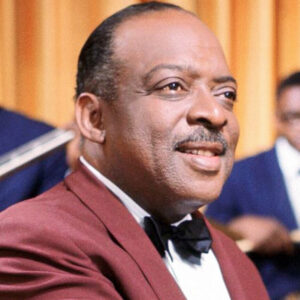
William James “Count” Basie, born on August 21, 1904, in Red Bank, New Jersey, was a monumental figure in jazz history, whose influence during the Swing Era was unparalleled. Basie’s journey into music started with a foundation in stride piano, leading him to eventually form one of the most distinguished big bands of the 20th century. His band’s sound, characterized by a blend of improvisational jazz and a strong blues influence, set the stage for the Swing Era, making jazz one of the predominant music styles of the time.
Basie’s big band, formed in the early 1930s, was celebrated for its innovative use of the rhythm section to drive the swing feel, setting it apart from other bands of the era. The “All-American Rhythm Section,” composed of Basie on piano, Freddie Green on guitar, Walter Page on bass, and Jo Jones on drums, was central to this sound, providing a lighter, more flexible beat that defined the Basie style. This approach not only solidified swing as a major jazz style but also laid the groundwork for future developments in jazz music.
Count Basie’s contributions to jazz were not limited to his unique band sound. He was a master at spotting talent, and his band served as a launching pad for many future jazz luminaries. The Count Basie Orchestra was a breeding ground for innovation, with arrangements that often highlighted the strengths of its members, leading to memorable solos and compositions that have become jazz standards. “One O’Clock Jump” and “Jumpin’ at the Woodside” are just a couple of the hits that came out of this creative powerhouse.
Beyond his musical innovations, Basie’s legacy includes his role in promoting racial integration within the music industry. His band was one of the first to feature both black and white musicians, challenging the status quo of segregated bands and venues. This commitment to integration was a significant contribution to the civil rights movement, showcasing the power of music to transcend racial barriers.
Count Basie’s death on April 26, 1984, marked the end of an era, but his influence on jazz and American music remains indelible. His ability to balance musical complexity with widespread appeal helped elevate the status of jazz as a respected art form. Basie’s orchestra continues to perform, a testament to his enduring legacy and the timeless quality of his music. Through his pioneering spirit, Count Basie not only defined the Swing Era but also helped shape the future of jazz.
Woody Herman: The Band That Plays The Blues
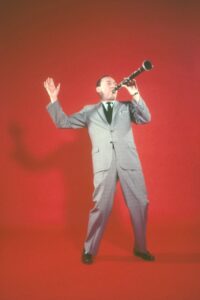
Woodrow Charles “Woody” Herman, born May 16, 1913, was a beacon of the swing era, infusing the jazz world with his unique talents as a clarinetist, saxophonist, singer, and big band leader. His journey into jazz royalty began with his early love for music, leading him to form the Woody Herman Orchestra. This ensemble became synonymous with innovation, pushing the boundaries of jazz and swing with a sound that was both vibrant and deeply rooted in jazz traditions.
Herman’s greatest contributions lay in his uncanny ability to assemble and sustain bands that were at the forefront of jazz. His First Herd, established in the critical period of 1944, just as the swing era was waning, was a testament to his vision. This band was celebrated for its explosive energy and technical brilliance, showcasing Herman’s leadership and his knack for selecting exceptionally talented musicians.
During the 1950s, Woody Herman continued to evolve with the Third Herd, embarking on successful tours in Europe and maintaining a high profile in the jazz scene. His bands were known for their dynamic arrangements and the freedom he gave his musicians, which encouraged a culture of creativity and innovation. This approach not only kept Herman’s music relevant but also helped nurture the next generation of jazz musicians.
Woody Herman’s legacy is not just in his music but also in his role as a mentor. He had an eye for talent and a genuine interest in fostering young musicians. His bands were incubators for talent, and many of his protégés went on to have significant careers in jazz. The music that emerged from Herman’s bands during the swing era and beyond has left an indelible mark on the landscape of American music.
Herman’s impact on jazz and swing music cannot be overstated. When he passed away on October 29, 1987, he left behind a rich tapestry of musical innovation that continues to influence musicians today. Woody Herman’s bands were more than just musical groups; they were a movement that propelled jazz into the future, ensuring its place as a critical component of American cultural heritage. His dedication to pushing musical boundaries while honoring the roots of jazz makes Woody Herman a pivotal figure in the history of swing music.
Tommy Dorsey: The Sentimental Gentleman of Swing
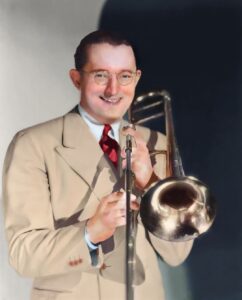
The swing era was a time of rich musical innovation, and few names shine as brightly as Tommy Dorsey, the “Sentimental Gentleman of Swing.” Dorsey’s influence on the era was profound, with a career that spanned several decades, marked by his virtuosic trombone playing and his leadership of one of the most successful orchestras of the time.
Tommy Dorsey was born into a musical family in 1905, and alongside his brother Jimmy, he would come to define an era. His smooth and melodic trombone style won him legions of fans and his band, both when performing alone and alongside Jimmy, was a fixture in the charts throughout the 1930s and ’40s. Dorsey’s band was a launching pad for many great musicians, including Frank Sinatra, whose career was catapulted to stardom during his time with the orchestra.
Dorsey’s hits, like “I’m Getting Sentimental Over You” and “On the Sunny Side of the Street,” are timeless classics that continue to evoke the spirit of an age where big band swing was the soundtrack of American life. His ability to create warm, sentimental, and forever musical moods made his music the backdrop to a nation’s dreams and dances.
Beyond his musical output, Dorsey’s business acumen and understanding of the entertainment industry allowed him to navigate the challenges of changing tastes and the eventual decline of the big band era. His television appearances in the 1950s brought swing music to a new generation and kept the spirit of the era alive.
Tommy Dorsey passed away in 1956, but his contribution to the swing era endures. His recordings continue to be a masterclass in the art of the big band, and his influence is felt in every trombone slide and swing beat heard in jazz today.
Stan Kenton: Progressive Concepts in Jazz
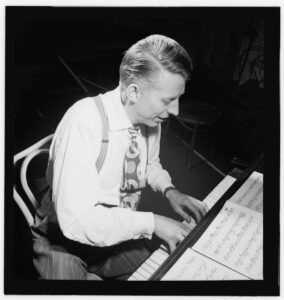
Stanley Newcomb Kenton, known as Stan Kenton, born on December 15, 1911, was not just a musician; he was an innovator whose impact on jazz during the swing era was profound. Kenton’s contributions were as much about the music itself as they were about the presentation and ambition of jazz as a serious art form. His early years were marked by an apprenticeship in various dance bands, where he honed his skills as a pianist and arranger.
Unlike many of his contemporaries, Kenton was not content to have his music merely provide a backdrop for dancers. Instead, he aimed to elevate jazz to the concert stage, aspiring to a blend of jazz rhythm with symphonic scope. This vision came to life with his orchestra, which, while it matured during the swing era, had aspirations that reached beyond the swing genre. Kenton’s bands were known for their powerful brass sections and innovative arrangements, pushing the envelope of what was considered mainstream jazz at the time.
His original compositions, such as “Shelly Manne,” were infused with a blend of jazz and twentieth-century European classical influences, showcasing his unique and ambitious approach to jazz. Kenton’s music was characterized by its complexity and a constant striving for new sounds and textures, which sometimes led to controversy but always reflected his dedication to musical innovation.
Kenton’s legacy in the swing era is marked by his relentless pursuit of a new form of jazz expression. While he may not have swung like Count Basie, his influence was felt in the way he challenged the boundaries of jazz, inspiring musicians to see the genre as a space for serious composition and creativity. His contributions during the swing era set the stage for the progressive jazz movements that would follow.
Stan Kenton passed away on August 25, 1979, but his ambition and innovative spirit continue to echo in jazz music. His insistence on pushing the boundaries of jazz has made a lasting impression on the genre, ensuring that his influence is felt long after the end of the swing era. Kenton’s work redefined the possibilities of jazz, and his efforts to bring the genre into the concert hall have left an indelible mark on the history of American music.
Earl ‘Fatha’ Hines: The Father of Modern Jazz Piano
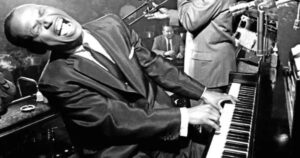
Earl Kenneth Hines, affectionately known as Earl “Fatha” Hines, was a paragon of jazz whose musical innovations during the swing era cemented his status as an architect of modern jazz piano. Born on December 28, 1903, Hines’s career spanned more than half a century, during which he developed a technique of “trumpet-style” piano playing, characterized by strong, octaved melody lines that mirrored the phrasing of a horn. This style was revolutionary and laid the groundwork for modern jazz piano.
During the swing era, Hines led one of the most renowned big bands, featuring a roster of future jazz luminaries. The band’s music was a synthesis of swing and Hines’s unique approach to piano, merging the rhythmic drive of swing with adventurous harmonies and structures. Hines’s band served as a bridge between the earlier jazz styles of ragtime and New Orleans and the emerging complexities of bebop.
Hines’s compositions and stylings influenced a generation of jazz pianists, including greats like Jess Stacy, Art Tatum, Teddy Wilson, Nat “King” Cole, and Mel Powell. His recording sessions from the 1920s onward are treasure troves of jazz evolution, capturing the transition from the early sounds of jazz to the more sophisticated swing style. Through these recordings, Hines’s influence spread far beyond his own performances, inspiring countless musicians.
“Fatha” Hines was not just a player; he was a visionary. His ability to anticipate and contribute to the development of jazz earned him a revered place in its history. His orchestra’s rendition of “G.T. Stomp” and other classics are seen as milestones in the swing genre. His performances were not mere entertainment; they were influential acts of musicianship that challenged and expanded the vocabulary of jazz piano.
When Earl Hines passed away on April 22, 1983, the music world mourned the loss of a legend. Yet, his legacy lives on through the scores of pianists he influenced and the rich recordings he left behind. Hines was more than a musician; he was a seminal force in the development of jazz, whose contributions helped shape the soundtrack of the 20th century.
Glenn Miller: Trombone Master In the Mood for Swing
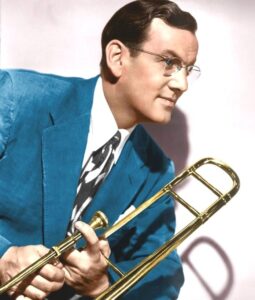
Alton Glenn Miller, born in Iowa in 1904, was the embodiment of the swing era’s music. His unique sound, defined by a clarinet holding the melody over a saxophone section, became an anthem for a generation. Miller’s big band was a dominating force in the late 1930s and early 1940s, producing a stream of hits that remain emblematic of the era.
Miller’s innovative approach to music arrangement and his mastery of the trombone distinguished his band from others. Under his leadership, the Glenn Miller Orchestra became synonymous with the swing era, their music capturing the zeitgeist of pre-war America. His hit songs like “In the Mood” and “Moonlight Serenade” define the swing era for many, their enduring popularity a testament to Miller’s genius.
While many swing bands played for dancing crowds, Miller’s music transcended dance halls, reaching radios and record players across the country. His orchestra’s distinctive swing jazz style dominated the music charts and brought big band music into the mainstream. Miller’s influence extended beyond entertainment; his band’s morale-boosting performances for troops during World War II showcased his patriotism and the unifying power of his music.
Tragically, Miller’s career was cut short when his plane disappeared over the English Channel in 1944. Yet, his contribution to the swing era and American music remains unmatched. His legacy is not only in the notes and rhythms of his compositions but also in the joy and comfort his music brought to millions during challenging times.
Glenn Miller’s sound was the sound of an era—a blend of innovation, rhythm, and melody that continues to captivate listeners and inspire musicians. His specific contributions to the swing era helped shape the course of modern music, and his influence will resonate for generations to come.
Cab Calloway: The Hi-De-Ho Man of Swing
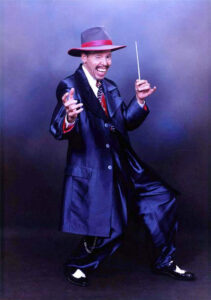
Cabell “Cab” Calloway III, born on December 25, 1907, was a luminary in the world of jazz, a showman whose exuberant performances captivated audiences and helped to define the swing era. With his grandiose stage presence and his orchestra’s infectious rhythms, Calloway became an icon of the big band era, known for his charismatic leadership and innovative music.
Calloway’s unique blend of jazz and vaudeville entertained and thrilled listeners. He was not just a bandleader but a masterful entertainer, whose performances were punctuated by his dynamic scat singing and trademark dance moves, including wildly flinging his mop of hair. These antics, combined with his musical prowess, set him apart from his contemporaries.
His orchestra was one of the most beloved bands of the swing era, appealing to both die-hard jazz enthusiasts and the wider public. Calloway’s ability to engage with his audience, along with his creative showmanship, brought joy to millions and made jazz more accessible. Songs like “Minnie the Moocher” became anthems of the age, their catchy melodies and Calloway’s playful vocal improvisations becoming emblematic of the era.
Beyond entertainment, Calloway’s music had a significant cultural impact. His work during the swing era was pivotal in shaping the sound of jazz and big band music, and he is credited with bringing African American music to a broader audience. His performances broke barriers and paved the way for future generations of musicians.
Even after the height of the swing era, Calloway remained a significant figure in music and pop culture. His career, which spanned over 65 years, is a testament to his enduring appeal and the lasting impact of his contributions to music. Cab Calloway’s legacy as a band leader, performer, and innovator continues to resonate, ensuring his place in the annals of jazz history.
Jimmy Lunceford: The Saxophone Sophisticate “Rhythm Is Our Business”
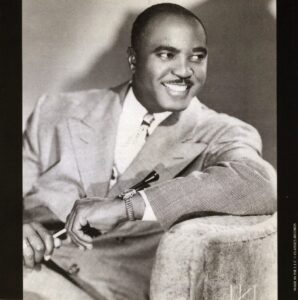
James Melvin “Jimmie” Lunceford, an innovator of the swing era, was more than just a bandleader and alto saxophonist; he was a visionary whose rhythmic ingenuity influenced the course of jazz. Born on June 6, 1902, Lunceford’s music was a blend of precision and swing, a rhythmic vitality that became the hallmark of his orchestra.
Lunceford’s contributions to the swing era were marked by his disciplined yet appealing orchestra, which stood out for its musical sophistication and showmanship. His big band was one of the most influential of its time, known for tight musicianship and arrangements that were both intricate and accessible. The band’s performances were exhilarating, often characterized by their high energy and the polished presentation that made them a hit with audiences across America.
Jimmie Lunceford’s unique beginning in the world of jazz set him apart. He emphasized musical education and precision, which was reflected in the excellence of his band’s performances. This approach not only entertained but also educated listeners, elevating the appreciation of jazz music.
His legacy in the swing era is also notable for the stylistic developments he brought to the music. Lunceford’s band had a distinct sound, blending jazz with other contemporary musical trends, and his influence extended beyond his own bandstand. He paved the way for future big bands, setting a standard for what audiences could expect from a live jazz performance.
Even after his untimely death in 1947, Lunceford’s impact on the swing era and jazz music remained. His innovative techniques, his emphasis on musicianship and showmanship, and his commitment to pushing the boundaries of jazz established him as a pioneer whose work continues to resonate with musicians and audiences alike.
Harry James: Flash, Drive and Dexterity
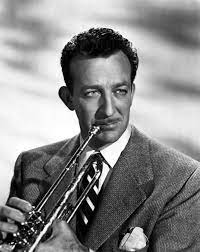
Harry Haag James, born on March 15, 1916, was a virtuoso trumpeter whose big band was a defining force of the swing era. His band, formed in 1939, became one of the most popular of the era, characterized by James’ skillful playing and innovative musical arrangements. James was renowned for his powerful and emotive sound, which helped to elevate the trumpet as a lead instrument in big band music.
His contributions to the swing era were immense, with hits that were cornerstones of the period’s soundtrack. James’ influence extended beyond his own performances; his arrangements and style of play resonated with and inspired a generation of musicians. His renditions of songs like “Sing Sing Sing” and “One O’Clock Jump” featured solos that showcased his technical prowess and musical sensitivity.
James’ band was known not just for its musical excellence but also for its ability to swing, a key element of the era’s dance-centric appeal. His orchestra’s ability to get people moving made his music a staple at dance halls and on the airwaves. The energy and passion of James’ music captured the spirit of the time and played a significant role in the swing movement’s popularity.
Beyond his life as a bandleader, James was a celebrated solo artist, whose recordings continued to influence jazz long after the peak of the swing era. He was able to adapt to the changing tastes in music, maintaining a successful career well into the latter part of the 20th century. His dedication to his craft ensured that his music remained relevant, and his recordings are still cherished by jazz enthusiasts today.
Harry James passed away on July 5, 1983, but his legacy as one of the most dynamic and beloved figures of the big band era endures. His specific contributions to the swing era — through his trumpet playing, band leadership, and musical arrangements — have secured his place in history as one of the greats of American jazz.
Jack Teagarden: Swinging the Trombone
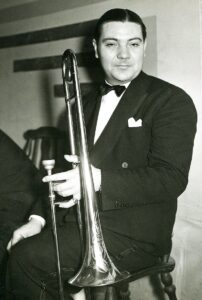
Jack Teagarden, fondly remembered as “Big T,” was a towering figure in the world of jazz and a significant architect of the Swing Era. Born Weldon Leo Teagarden in 1905, this Texas native would go on to redefine the trombone’s place in jazz with his innovative playing style. Teagarden’s career spanned from the roaring ’20s through the transformative years of swing, and he left an indelible mark with his warm, fluid sound that combined technical mastery with soulful expression.
Teagarden’s trombone sang with a voice that was both powerful and tender, embodying the spirit of the blues with each note. In an era dominated by the likes of Louis Armstrong, with whom Teagarden would enjoy a long-standing friendship and collaboration, “Big T” stood out for his ability to seamlessly weave a “blue feeling” into his solos and for his laid-back yet sophisticated approach to improvisation. This ability to swing effortlessly made him a natural fit for the Swing Era, where he contributed to shaping the soundtrack of an age.
His influence during the Swing Era was not limited to his playing; Teagarden was also a bandleader, a vocalist, and a mentor to many. His bands were incubators for emerging talent, and his recordings from the era serve as a masterclass in swing. Songs like “I Gotta Right to Sing the Blues” and “Basin Street Blues” not only showcased his virtuosity but also his soulful vocal style, further cementing his legacy as a versatile and influential musician who could swing with the best of them.
Teagarden’s specific contributions to the Swing Era extended beyond his own recordings. His collaborations with Benny Goodman, including the memorable sessions that produced “I Gotta Right to Sing the Blues,” highlight his role as a key player in the era’s defining moments. He was not merely a participant; he was a shaper of the Swing Era’s musical landscape. “Big T’s” enduring legacy in the history of jazz is not only that of a remarkable trombonist but also as a true embodiment of the spirit of swing, whose musical language continues to inspire generations of musicians.
Ben Pollack: Drumming Powerhouse and Big Band Leader
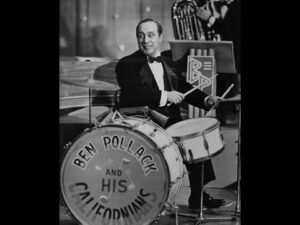
Ben Pollack, born on June 22, 1903, in Chicago, Illinois, was not only a gifted drummer and bandleader but also a visionary talent scout during the burgeoning swing era. Often referred to as the “Father of Swing,” Pollack’s career spanned several critical phases of early jazz and swing music.
From the mid-1920s, Pollack led one of the country’s most popular dance bands, which became a veritable incubator for some of the swing era’s most significant musicians. It was his band that served as the launching pad for future stars such as Benny Goodman, Glenn Miller, and Jack Teagarden. Pollack had an uncanny ability to recognize and nurture young talent, shaping the sounds that would come to define a generation.
Pollack’s specific contribution to the swing era extended beyond bandleading. His recordings in the late 1920s and early 1930s, including hits like “Deed I Do” and “The Last Time I Saw Chicago,” captured the buoyant, effervescent spirit that would characterize swing music. His style blended structured arrangements with opportunities for spirited solos, setting the stage for what would become the hallmark of swing bands.
Amidst the Great Depression, Pollack’s band continued to evolve, and although financial hardships eventually led him to disband his orchestra, he remained a respected figure in the music industry. He relocated to California and continued to perform with smaller groups, adapting to the ever-changing landscape of American popular music.
Louis Prima: The Trumpeting Dynamo of Swing and Showmanship
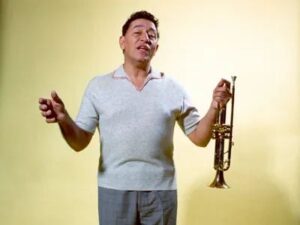
Louis Prima, born in the heart of New Orleans on December 7, 1910, blossomed in the cradle of jazz, destined to become one of its most colorful and enduring characters. Prima’s early life in Louisiana’s vibrant music scene laid the foundation for a career that would span multiple genres and decades. He wielded his trumpet and voice with a rare combination of raw energy and finesse, quickly earning a reputation as a dynamic performer and bandleader. His early forays into jazz were marked by a spirited blend of Dixieland and swing, reflective of his upbringing in a city synonymous with musical innovation.
As swing music began its ascent to mainstream popularity, Prima’s career mirrored its rise. His exuberant onstage personality, coupled with a raspy, enchanting voice, became signatures that charmed audiences nationwide. Prima wasn’t just a musician; he was a showman, and his concerts were events that transcended typical performances. They were parties, and everyone was invited. This charismatic approach made him a natural fit for the swing era, and his compositions during this time contributed to the soundtrack of an age.
Prima’s influence on the swing era was not limited to his performances. As a songwriter, he penned tunes that captured the essence of the genre, such as the irrepressible “Sing, Sing, Sing,” which became a standard for swing music and a centerpiece for Benny Goodman’s orchestra. This particular piece showcased Prima’s understanding of what made swing music move: the infectious rhythms that compelled dance, the brassy, bold instrumentals, and the undeniable joy embedded in every note.
Beyond the stage and studio, Prima’s contributions to the swing era extended into the cultural fabric of the time. He was a pioneer, blending Italian-American musical traditions with the African-American roots of jazz, creating a sound that was uniquely his own. His style was a precursor to the melding of jazz with early R&B, rock, and even boogie-woogie, showing the versatility and adaptability of swing as a genre. Prima’s music was not just a reflection of the swing era; it was a force that helped shape its future direction.
Though Louis Prima passed away in 1978, his legacy endures. His contributions to the swing era echo through the ages, influencing musicians and delighting new generations of fans. The swing era may have been a moment in time, but Prima’s music is timeless, a testament to his talent and the enduring appeal of swing music. In the annals of jazz history, Louis Prima stands as a towering figure, a man who brought the spirit of New Orleans to the world and left it swinging to his tunes long after the spotlight faded.
Bunny Berigan: Trumpet Virtuoso and the Voice of Swing
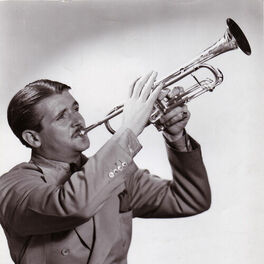
Roland Bernard “Bunny” Berigan remains one of the most charismatic and talented figures of the swing era. Born on November 2, 1908, in Hilbert, Wisconsin, Berigan’s musical journey was marked by his powerful trumpet sound that became a defining feature of the period. His career, although cut tragically short, left an enduring legacy in the annals of jazz history.
Berigan’s ascent to stardom in the jazz world was meteoric, owing to his dynamic trumpet playing that combined technical brilliance with a soulful lyricism. By the mid-1930s, he had become one of the most sought-after trumpeters, playing with the likes of the Benny Goodman and Tommy Dorsey orchestras. His fearless improvisations and ability to play high, fast, and with intense emotion made his sound instantly recognizable.
In the swing era, Berigan’s contributions went beyond his instrumental prowess; he was also a bandleader who led groups that delivered some of the period’s most vibrant performances. His recording of “I Can’t Get Started” is an emblematic example, showcasing his remarkable range and depth of feeling, and has become a jazz standard.
Berigan’s influence extended to his recordings, with more than six hundred to his name. He served as a direct link between the jazz of the 1920s and the swing style that dominated the 1930s. His sound encapsulated the era’s spirit, characterized by a blend of swing rhythms and a penchant for musical experimentation.
Though Bunny Berigan passed away on June 2, 1942, his music continues to captivate jazz lovers and musicians. His contributions to the swing era are celebrated for their passion and innovation. Berigan’s legacy endures not only in the recordings he left behind but also in the countless musicians he inspired, solidifying his place as a titan of jazz.
The Swinging Soloists and Stellar Sidemen
Chick Webb: The Backbone of the Big Band Drum
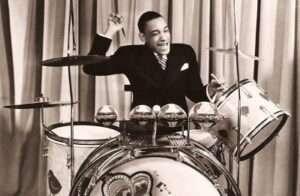
William Henry “Chick” Webb, whose life spanned from February 10, 1905, to June 16, 1939, was a towering figure in the pantheon of jazz music, not just for his drumming prowess but for his role as a bandleader during the swing era. Despite facing significant health challenges from a young age, Webb’s determination and talent led him to become one of the most respected musicians of his time.
Webb’s specific contribution to the swing era was monumental, as he led one of the era’s most esteemed big bands. His band became the house band at the famed Savoy Ballroom in Harlem, a venue that was the epicenter of swing dancing. Under Webb’s leadership, his orchestra became a benchmark of excellence, known for their energetic performances and musical precision, which other bands aspired to match.
His influence extended beyond the walls of the Savoy. Webb was pivotal in nurturing the talents of many young musicians, including the legendary Ella Fitzgerald. His encouragement and support launched careers and pushed the boundaries of what swing music could be.
As a drummer, Webb’s technique was innovative, incorporating energetic rhythms that helped define the sound of the swing era. His style was a blend of power and nuance, which inspired generations of drummers that followed. Webb’s ability to engage both the dancers and listeners alike made his performances legendary.
Though his life was brief, Chick Webb’s impact on jazz and swing was profound. His contributions to the music scene of the Harlem Renaissance and the swing era are celebrated, and his legacy is carried forward in the rhythm of every swing and jazz piece that echoes his innovative beats. Webb was not just a musician; he was a force that changed America’s musical landscape.
Coleman Hawkins: The Tenor That Roared
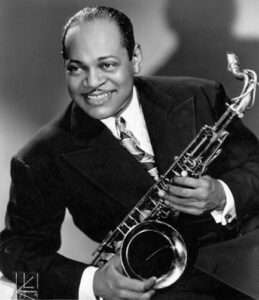
Coleman Hawkins, affectionately known as “Hawk,” stood as a titan in the jazz world, his tenor saxophone carving out the harmonic possibilities that would come to define the sound of swing and beyond. Born on November 21, 1904, in Saint Joseph, Missouri, Hawkins was a child prodigy who initially trained in cello and piano before embracing the saxophone. By the age of 20, he was already performing with the Fletcher Henderson Orchestra, where he remained for a decade, becoming the first prominent jazz tenor saxophonist and effectively setting the stage for the instrument’s central role in jazz.
Hawkins’s sound—rich, vigorous, and brimming with inventive phrasing—was pivotal in the transition from the ensemble-focused Dixieland style to the soloist-centric swing. His 1939 recording “Body and Soul” remains an emblematic masterpiece, showcasing his innovative use of arpeggiated chords and improvisational genius. This record not only solidified his status as a jazz legend but also captivated millions, turning a multitude of listeners into jazz enthusiasts.
During the swing era, Hawkins’s work resonated deeply with both audiences and fellow musicians. His robust tone and bold, improvisational approach influenced a slew of saxophonists, including the likes of Sonny Rollins and John Coltrane. Hawkins had a knack for fusing the saxophone’s voice with the rhythmic drive of swing, making his music both a foundation and a catapult for the sounds that would evolve from it.
Beyond his technical prowess, Hawkins’s ability to convey emotion through his horn made him a beacon of expression within the big band landscape. He led various ensembles, collaborating with luminaries across the jazz spectrum, and never ceased pushing the boundaries of his craft. His participation in landmark sessions with Benny Goodman further cemented his influence and helped proliferate the swing style.
Hawkins’s contributions transcended mere performance. He was a mentor and an inspiration, an artist whose dedication to the exploration of music’s possibilities left an indelible mark on the annals of jazz. Coleman Hawkins passed away on May 19, 1969, but his legacy endures—a testament to the swing era and its everlasting impact on jazz music. His work remains a cornerstone, not just for tenor saxophonists, but for all who seek to understand the heart and soul of jazz improvisation.
Johnny Hodges: Duke’s Lead Alto and Beyond
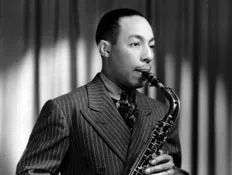
Johnny Hodges, an American jazz saxophonist, became a defining figure in the swing era through his long tenure with the Duke Ellington Orchestra. Born on July 25, 1907, Hodges grew up in Boston and quickly showed a prodigious talent for music. By the time he joined Ellington in 1928, he had already honed a distinctive sound on the alto saxophone, which would become a hallmark of the Ellington sound. With a rich, creamy tone and an expressive vibrato, Hodges’s playing on ballads was unparalleled, earning him the nickname “Rabbit” for his cool demeanor and smooth, hopping style.
Hodges’s contributions to the swing era were characterized by his ability to imbue a sense of effortless grace into the frenetic pace of the music of the time. His solos became central to many of Ellington’s biggest hits, including “Jeep’s Blues” and “Prelude to a Kiss,” showcasing his lyrical style that spoke directly to the emotions of the listener. Hodges was not just a performer but also a contributor to the orchestra’s repertoire, writing several pieces that became part of the band’s core music.
During the height of the swing era, Hodges became one of Ellington’s most reliable soloists, his alto saxophone often leading the reed section. His solos were a blend of the bluesy sophistication of the era and the burgeoning complexity that would lead to bebop. Despite the prominence of the swing rhythm, Hodges maintained a sense of melodic individuality that influenced countless saxophonists who followed.
After a brief period leading his own band in the early 1950s, Hodges returned to Ellington’s fold, where he remained until his death on May 11, 1970. His legacy is a testament to his importance in the swing era: Hodges was not just a musician but a voice that captured the spirit of an age. His playing, particularly with Ellington, remains a high watermark for the expressive potential of jazz saxophone, and his influence is still felt in the world of jazz today.
Art Tatum: The Virtuoso Pianist of Swing
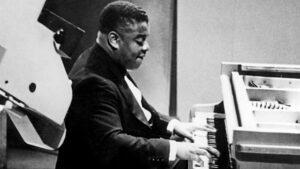
Art Tatum, a titan of the jazz piano, carved out a legacy as one of the most extraordinary virtuosos in jazz history, despite a visual impairment that would have stymied a lesser musician. Born on October 13, 1909, in Toledo, Ohio, Tatum’s prodigious talent transcended the swing era and influenced generations of pianists from various genres.
Tatum’s piano style was a sophisticated mélange of stride, swing, and classical influences, teeming with rapid-fire runs, intricate harmonic progressions, and flamboyant flourishes that left both audiences and fellow musicians awestruck. His technical brilliance and improvisational prowess were unmatched, and he could turn any tune into a complex, exhilarating journey. Even with the swing era’s emphasis on danceable rhythms and big band arrangements, Tatum’s solo performances stood out as singular masterpieces of the piano repertoire.
During the swing era, Tatum’s contributions were manifold. His recordings were a masterclass in solo jazz piano and were particularly influential on the bebop musicians who would emerge in the 1940s. Tatum’s reharmonization of popular standards and his ability to play at breakneck tempos without losing melodic clarity or harmonic richness made his music a bridge between the big band sound of the swing era and the more intricate bebop style.
Tatum’s performances were not just technical displays; they were infused with a deep understanding of the blues, which gave his music an emotional depth that resonated with listeners and musicians alike. His interpretations of ballads were as impactful as his uptempo numbers, revealing a tenderness and lyrical beauty that could move listeners profoundly.
Despite his passing on November 5, 1956, Tatum’s legacy endures. His recordings continue to inspire and challenge pianists across jazz and beyond. Art Tatum was not just a product of the swing era; he was a force of nature whose music transcended the confines of any single period, leaving an indelible mark on the fabric of American music.
Ben Webster: The Brassy Tone of the Tenor Sax
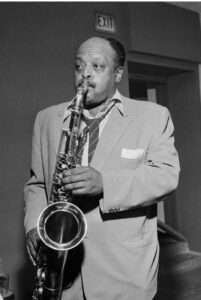
Ben Webster, born March 27, 1909, in Kansas City, Missouri, was a towering figure of the swing era, known for his robust and soulful tenor saxophone. Webster’s sound, marked by a husky timbre and a vibrato that could express the deepest sorrow or the highest joy, made him one of the iconic “big three” of swing tenors, alongside Coleman Hawkins and Lester Young.
Webster’s journey into the heart of jazz began in the vibrant musical scene of Kansas City, where he played with the Young Family Band, which included Lester Young. His early career saw him performing with the likes of Bennie Moten and the incomparable Duke Ellington, with whom Webster’s association would become legendary. His time with Ellington’s orchestra in the 1940s saw him contributing to some of the most memorable performances and recordings in jazz history.
A master of the ballad, Webster’s interpretations of slow numbers were peerless. His rendition of classics like “Chelsea Bridge” and “Sophisticated Lady” were marked by a profound emotional depth that resonated with audiences. But he was equally adept at uptempo numbers, swinging with an effortless grace and a formidable presence that commanded attention.
Webster’s contribution to the swing era went beyond his soloist role; he was a significant force in shaping the sound of the tenor saxophone in jazz. His approach combined the foundational rhythm of swing with the bluesy inflection of Kansas City jazz, creating a style that was emulated by many but matched by none. His music was a reflection of the swing era’s spirit—a synthesis of technical mastery and heartfelt expression.
Ben Webster’s legacy in jazz is immeasurable. Not only did he leave behind a body of work that continues to inspire musicians, but he also helped to define an era of American music. His tone, phrasing, and ability to convey emotion through his instrument remain benchmarks for tenor saxophonists. Webster passed away on September 20, 1973, in Amsterdam, but his music continues to swing, undiminished by time, a testament to his enduring contribution to the world of jazz.
Lionel Hampton: The Rhythmic Force on Vibes
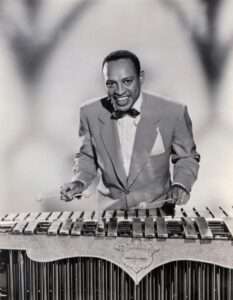
Lionel Hampton, known affectionately as “Hamp,” was a dazzling jazz vibraphonist, pianist, percussionist, and bandleader whose influence during the swing era remains indelible. Born on April 20, 1908, in Louisville, Kentucky, Hampton’s journey into jazz royalty began in the 1930s when he introduced the vibraphone into jazz with his virtuosic playing, marking a pivotal development in the genre.
Hampton’s legacy is often tied to his time with the Benny Goodman Quartet, where he became one of the first black musicians to play with white musicians in a group, breaking racial barriers and setting a precedent for future generations. His tenure with Goodman not only showcased his masterful musicianship but also exemplified his commitment to musical integration and innovation.
Leading his own orchestra, Hampton became synonymous with the exuberance of swing, with hits that encapsulated the era’s joyous spirit. His orchestra served as a launchpad for numerous future jazz legends, and his compositions, like “Flying Home,” became anthems that defined the sound of an era. Hampton’s performances were electric, often culminating in frenetic drum solos that left audiences in awe, securing his place as a showman par excellence.
Hampton’s contributions to swing extended beyond his performances; his dedication to music education led to the formation of youth bands and music scholarships, ensuring the perpetuation of jazz’s rich heritage. His impact was recognized by his induction into the Alabama Jazz Hall of Fame in 1992, a testament to his enduring influence on American music.
Even after the swing era waned, Hampton’s passion never dimmed. He continued performing well into his 90s, spreading the gospel of swing to all who would listen. His death on August 31, 2002, marked the end of a storied career, but his vibrant rhythms and the legacy of swing continue to resonate, a testament to the “King of the Vibes” and his indomitable spirit.
Billie Holiday: Swing Era’s Songstress
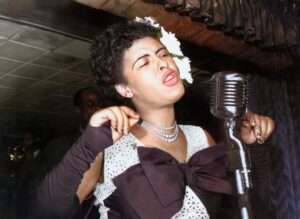
Billie Holiday, affectionately known as Lady Day, was a distinctive voice that resonated through the swing era and beyond, leaving an indelible mark on jazz and pop singing. Born on April 7, 1915, Holiday’s emotive delivery and unique vocal style transformed the approach to jazz singing. Her ability to convey deep emotion and to bend tempo and pitch set her apart as one of the era’s most influential artists.
Holiday’s work with pianist Teddy Wilson was seminal, producing music that was both innovative and accessible. Their recordings are considered classics, blending the swing of big bands with the intimacy of smaller ensembles. Holiday’s collaboration with Lester Young, which produced unforgettable tunes, was notable for its heartfelt expression and technical excellence. Young even bestowed upon her the nickname “Lady Day.”
Her song “Strange Fruit,” a haunting protest against the lynching of African Americans, showcased her ability to address serious social issues through her music, a rarity in the swing era. This song not only became one of her most famous but also a powerful symbol of the civil rights movement.
Holiday’s contributions to the swing era were profound. Her unique timing and phrasing influenced jazz music and modern singing. She broke new ground with her improvisational skill, turning songs into deeply personal statements. Despite facing significant personal challenges, her music remains a testament to her extraordinary talent and resilience.
Billie Holiday’s legacy extends far beyond her lifetime. As one of the greatest jazz vocalists of all time, she triumphed over adversity to change the genres of jazz and pop forever. Her influence continues to be felt by musicians and music lovers around the world, ensuring her place as a true icon in music history.
Gene Krupa: Drumming Up the Swing
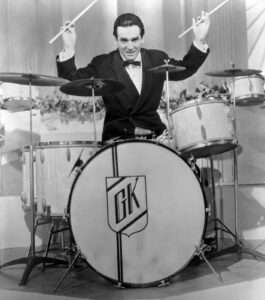
Gene Krupa, born on January 15, 1909, in Chicago, was a trailblazing American jazz drummer and bandleader who became an emblematic figure of the swing era. His dynamic style and showmanship on the drums helped catapult the instrument to the forefront of jazz orchestration. Krupa’s influence extended far beyond his flashy solos; he was pivotal in defining the role of the drummer as a central figure in a big band, rather than merely a timekeeper.
From the late 1930s, Krupa’s work with Benny Goodman’s band, particularly the legendary 1937 recording of “Sing, Sing, Sing,” showcased his innovative use of tom-toms and energetic style, which became a defining sound of the era. His drumming was not just rhythmic but melodic, bringing a new level of sophistication to jazz percussion.
Krupa’s solo career was equally significant. He led his own band and was a star in his own right, one of the first drummers to do so. His charismatic performances and technical prowess made him a household name and introduced jazz to a broader audience. In the process, he inspired future generations of drummers.
Despite facing personal and professional challenges, Krupa’s passion for music never waned. He continued to perform and record until the end of his life, leaving behind a rich legacy of recordings that continue to influence musicians. His contributions during the swing era helped shape the soundtrack of the time and played a crucial role in the evolution of jazz music.
Gene Krupa’s death in 1983 marked the end of an era, but his legacy endures. As the first drummer inducted into the Modern Drummer Hall of Fame, his impact on the world of jazz and the position of the drummer within it cannot be overstated. Krupa was not just a musician; he was a phenomenon that changed the face of swing and drumming forever.
Benny Carter: A Multifaceted Jazz Giant
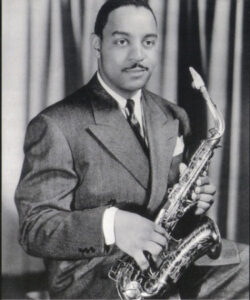
Benny Carter, an extraordinary musician whose career spanned eight decades, was a masterful alto saxophonist, a prolific composer, a trailblazing big band leader, and an influential arranger who left an indelible mark on the swing era. Born on August 8, 1907, in New York City, Carter was a self-taught musician whose skills quickly propelled him to the forefront of jazz.
During the swing era, Carter’s arrangements and compositions helped shape the big band sound. His work in the 1920s, particularly his innovative use of jazz solos intertwined with ensemble playing, allowed big bands to achieve a new level of musical freedom and expression. His contributions as an arranger were pivotal, leading the breakthrough that defined the era’s musical style.
As a saxophonist, Carter’s impact was equally significant. Along with Johnny Hodges, he set the standard for alto saxophone players during the swing era. His ability to double on trumpet was nearly unique, further showcasing his versatility and skill as a musician.
Carter was also an important figure in Hollywood’s racial integration and a mentor to many younger musicians. His talent as a teacher extended his influence beyond his own performances, ensuring his legacy would continue through the musicians he inspired.
Benny Carter’s death on July 12, 2003, marked the end of a legendary life in music, but his contributions to the swing era and jazz as a whole continue to resonate. As one of the principal architects of the big band swing style, Carter’s innovative spirit and exceptional musicianship cement his status as one of the unsung champions of jazz.
Artie Shaw: The Clarinet Innovator
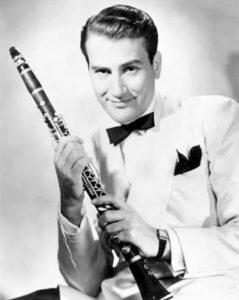
Artie Shaw, born Arthur Jacob Arshawsky on May 23, 1910, in New York City, was a clarinet virtuoso whose artistic endeavors defined the big band and swing era. Shaw’s 1938 recording of “Begin the Beguine” encapsulated the essence of the swing movement and catapulted him to stardom. His innovative musical approaches and charismatic band leading made his orchestra one of the defining sounds of the 1930s and 1940s.
Renowned for his exceptional musicianship, Shaw was not content to rest on his laurels. He was an artist who constantly sought to evolve his sound and push the boundaries of swing music. His recordings were marked by sophisticated arrangements and a willingness to explore, blending swing with other musical styles, which kept his work fresh and relevant.
Shaw’s band was a launchpad for many musicians who would go on to have significant careers in jazz. His keen ear for talent and the high standard of performance he demanded contributed to the development of numerous swing era luminaries.
His innovative spirit led him to form various bands, each with its unique character, yet all bore the unmistakable imprint of his creative vision. Shaw’s ability to attract and inspire top-tier talent was matched by his skill in crafting arrangements that showcased the individual strengths of his musicians while maintaining a cohesive sound.
Despite retiring from public performances in the 1950s, Shaw’s influence on jazz and swing music remains potent. His contributions to the swing era extend beyond his clarinet mastery and band leadership; they include his compositions, arrangements, and the standard he set for musical excellence. Shaw passed away on December 30, 2004, leaving behind a legacy that continues to inspire and influence musicians and listeners alike.
Anita O’Day: The Jezebel of Jazz
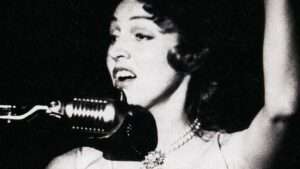
Anita O’Day, born Anita Belle Colton on October 18, 1919, was a jazz singer who rose to fame during the swing era, not only for her distinctive voice but also for her unconventional style and daring improvisations. Her career spanned various styles including swing, big band, bebop, and West Coast jazz, reflecting her versatility and enduring appeal.
O’Day’s contributions to swing were profound. In an era dominated by male bandleaders and vocalists, she carved out a space for herself with her unique sense of rhythm and phrasing, which often mirrored the instrumental solos of the time. She was known as the “Jezebel of Jazz,” a moniker that captured her free spirit and her transformative influence on jazz vocals.
Her time with drummer Gene Krupa’s orchestra catapulted her to stardom. The partnership yielded hits that have since become jazz standards. O’Day’s ability to swing was unmatched; she could imbue a song with both the relentless tempo of the big band sound and the intimate emotions of a ballad.
O’Day’s distinct approach reshaped the role of the singer in big band music, turning the vocalist into an instrument equal to any other in the band. Her improvisational skills and refusal to be constrained by the traditional limits of the genre inspired other musicians to explore and innovate.
Despite struggles in her personal life, O’Day’s musical legacy is undeniable. She is remembered as one of the most talented and influential vocalists in jazz, whose contributions helped define the swing era and whose style continues to influence singers today.
Teddy Wilson: Gentleman of Swing
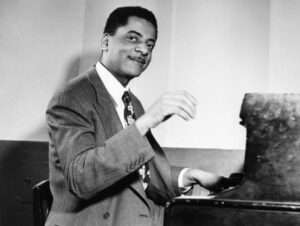
Teddy Wilson, born Theodore Shaw Wilson on November 24, 1912, in Austin, Texas, was a jazz pianist whose elegant style and technical proficiency established him as a leading figure in the swing era. Recognized by critics as the definitive swing pianist, Wilson’s influence on jazz music cannot be overstated.
Wilson’s mastery of the piano found him gracing the recordings and performances of many great swing bands, including those led by Benny Goodman. His work with Goodman broke racial barriers, making Wilson one of the first black musicians to perform widely with white musicians. This collaboration was not just musically significant but also historically important.
As a solo artist, Wilson’s sophisticated “trumpet style” piano playing combined the power of Earl Hines with a lyrical grace all his own. He forged a path that was both innovative and steeped in the traditions of earlier jazz pianists. His solo work and leadership of his own groups further solidified his place in jazz history.
Beyond performance, Wilson was a respected arranger and composer. His contributions to the swing era included arrangements that allowed for the seamless integration of solos with ensemble playing, elevating the big band sound to new artistic heights.
Teddy Wilson passed away on July 31, 1986, but his contributions endure. He left a legacy of recordings that continue to inspire pianists and listeners alike, ensuring his place as one of the swing era’s most important and enduring figures.
Roy Eldridge: Little Jazz: Blazing a Trail for Bebop
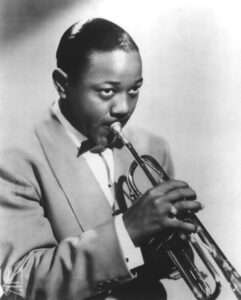
Roy Eldridge, known as “Little Jazz,” was born on January 30, 1911, in Pittsburgh, Pennsylvania. His virtuosity on the trumpet made him one of the most influential musicians of the swing era, bridging the gap between the early jazz stylings of Louis Armstrong and the bebop innovations of Dizzy Gillespie. Eldridge’s powerful sound and daring improvisations earned him a place among jazz’s elite.
During the swing era, Eldridge’s contributions were both groundbreaking and diverse. He joined Gene Krupa’s Orchestra in 1941, where his solos became a centerpiece of the band’s performances, thrilling audiences and setting a new standard for jazz trumpeters. His technique combined Armstrong’s lyrical melody with a fiery edge that presaged the modern jazz era.
Eldridge’s influence extended beyond his solo work. As an arranger and bandleader, he crafted sounds that were ahead of their time, infusing the big band format with a spirited complexity. His collaborations with vocalists like Billie Holiday further showcased his versatility and the breadth of his musical impact.
Beyond his technical prowess, Eldridge was known for his resilience in the face of the era’s racial barriers. He was one of the first African American musicians to become a prominent member of otherwise white bands, paving the way for future generations of artists.
Roy Eldridge’s death on February 26, 1989, marked the end of a remarkable career that spanned nearly five decades. His legacy lives on in the recordings that continue to inspire trumpeters and jazz enthusiasts around the world. Eldridge remains a towering figure in jazz history, a testament to the enduring power of swing.
Sidney Bechet: From New Orleans to Paris:
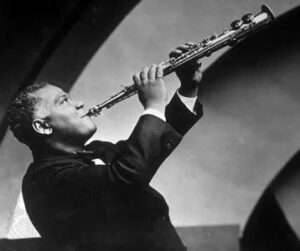
Sidney Bechet, born on May 14, 1897, in New Orleans, emerged as one of the first notable soloists in jazz, alongside Louis Armstrong, and played a significant role in the development of swing. Bechet’s virtuosity on the saxophone and clarinet and his powerful wide vibrato set him apart in an era when the collective sound of a band was the norm.
He was among the first to elevate the saxophone, particularly the soprano sax, to a level of soloistic prominence in jazz, which had been dominated by the cornet and trumpet. His playing style was characterized by a passionate intensity and a unique sense of melody that left a lasting impact on the swing era.
Bechet’s contributions to jazz extended beyond his instrumental prowess. He was a masterful composer, with works like “Si Tu Vois Ma Mère” that have become jazz standards. He also helped in expanding the jazz genre’s reach, touring extensively in Europe and influencing the international jazz scene.
His collaboration with numerous jazz legends, including Duke Ellington and Armstrong, and his recordings during the swing era helped to define its sound. Bechet’s music was not just entertainment; it was a statement of artistry that resonated with emotion and technical skill.
Sidney Bechet’s death on May 14, 1959, his 62nd birthday, marked the loss of a jazz giant. His legacy as a pioneer of early jazz and a key figure in the swing era remains profound, influencing generations of musicians with his soulful playing and innovative spirit.
Lester Young: The President of the Tenor Saxophone
Lester Young, known affectionately as “Prez” by his colleagues, was born on August 27, 1909, in Woodville, Mississippi. He rose to become one of the swing era’s most influential tenor saxophonists, whose relaxed, smooth playing style contrasted sharply with the robust, aggressive styles of his contemporaries.
Young’s contributions to jazz were profound and multifaceted. His tenure with the Count Basie Orchestra from 1934 was marked by iconic recordings that showcased his innovative approach to the tenor saxophone. His solos were characterized by a light, airy tone and a laid-back rhythmic feel that would come to define the “cool” school of jazz playing.
As a musician, Young’s individual voice on the saxophone offered a new musical language that was less about the instrument’s power and more about its potential for lyrical expression. This approach influenced a generation of jazz musicians, including Stan Getz and John Coltrane, who found inspiration in Young’s unique sound.
Beyond his instrumental prowess, Young’s sense of style and his nonchalant attitude towards life became emblematic of the jazz musician’s ethos. His signature pork pie hat and loose suit were as much a part of his legacy as the notes he played.
Lester Young’s passing on March 15, 1959, marked the loss of a giant in jazz history. Yet, his contributions continue to resonate, his recordings remain cornerstones of jazz education and appreciation, and his spirit lives on in the countless musicians who walk in the footsteps of his cool, unhurried swing.
Charlie Christian: Swinging the Strings
Charlie Christian stands as a colossal figure in the history of jazz, not just for his masterful guitar playing, but for the indelible mark he left on the music world during the swing era. Born in Bonham, Texas, in 1916, Christian’s family moved to Oklahoma City, which became the launchpad for his storied career. His early life was steeped in music, with his father’s love for the guitar trickling down to young Charlie, who would eventually revolutionize the instrument’s role in jazz.
Christian’s journey into the annals of jazz greatness began in earnest when he joined Benny Goodman’s band in 1939. With Goodman, Christian not only contributed to the swing era’s soundtrack but redefined the electric guitar as a solo instrument. His solos were a revelation, marked by fluidity and a melodic approach that transformed the guitar into a voice as expressive as any horn in the band. Numbers like “Solo Flight” captured his innovative spirit and cemented his legacy as a jazz guitar’s king of swing.
In addition to his innovative playing, Christian’s tenure with Goodman’s sextet and orchestra was characterized by his improvisational genius and harmonic sophistication. He forged a new path for jazz guitarists, inspiring countless followers with his technique and his bold, inventive use of the electric guitar. His influence extended beyond the swing era, setting the stage for the bebop revolution and affecting the trajectory of modern jazz.
Despite his brief life—he passed away at just 25—Christian’s impact was monumental. He is remembered not only for his virtuosity but also for his pioneering spirit and his role in shaping the sound of a generation. His recordings remain a testament to his genius, continuing to inspire musicians and listeners alike with the beauty and innovation of his art.
Charlie Christian’s legacy lives on as a touchstone for guitarists and jazz enthusiasts, a symbol of the swing era’s vibrancy, and a beacon for those who dare to innovate. His music still resonates, a timeless ode to the power of jazz and the electric guitar’s expressive potential in the hands of a master.
Joe Venuti: Jazz Violin Pioneer and Master of Swing
Joe Venuti, a name synonymous with the birth of jazz violin, masterfully carved a niche for himself in the pantheon of swing era legends. Born in Philadelphia in 1903 to Italian immigrant parents, Venuti’s prodigious talent on the violin emerged early. He attended the James Campbell School, where he met his lifelong friend and collaborator, guitarist Eddie Lang. Together, they pioneered a string-based jazz sound that became a cornerstone of the genre.
Venuti’s influence on the swing era is indelible. He was a virtuoso who brought a vivacious and intricate style to the violin, an instrument not traditionally associated with jazz. His innovative techniques, such as using muted strings and playing in the higher registers, gave the violin a new voice within the swing orchestras of the time. He played with jazz greats like Bix Beiderbecke and Benny Goodman, and his recordings in the 1920s and 1930s set the stage for the swing era’s classic sound.
His specific contribution to the swing era was multifaceted. First, he expanded the jazz lexicon with his inventive improvisations, influencing generations of musicians. Second, his partnership with Eddie Lang showed how string instruments could swing as hard as brass and reeds. Third, Venuti’s charisma and stage presence made him a popular figure, helping to popularize jazz music across America.
Despite his contributions, Venuti’s career was not without challenges. The Great Depression and the advent of bebop changed the jazz landscape, and his style fell out of favor. Nonetheless, he persisted, playing in small clubs and continuing to influence musicians. By the 1970s, a resurgence of interest in traditional jazz brought Venuti back into the limelight, allowing new audiences to appreciate his genius.
Joe Venuti’s legacy is that of a pioneer who defied conventions and brought the violin front and center in the jazz world. His swing era recordings remain a testament to his creativity and are still celebrated for their innovative spirit and technical mastery.
Eddie Lang: Father of Jazz Guitar and Swing Innovator
Eddie Lang, born Salvatore Massaro on October 25, 1902, in Philadelphia, is often hailed as the father of jazz guitar. His contributions to the swing era resonate through the annals of jazz history, his skill and artistry pioneering a path for the guitar as a lead instrument in jazz ensembles. A classically trained musician, Lang brought a sophistication and inventiveness to the guitar that had previously been relegated to the background in early jazz bands.
During the 1920s and 1930s, Lang’s collaborations with jazz violinist Joe Venuti crafted the template for string-based jazz ensembles, their interplay becoming a hallmark of the genre. Lang’s delicate yet intricate picking style complemented the violin’s fluidity, creating a swing feel that would come to characterize the era. His ability to blend with other musicians, notably with Venuti, established the guitar as an essential voice in the jazz conversation.
Lang’s influence extended beyond his recordings and live performances; he was a true innovator, incorporating techniques that would become standard in later jazz guitar playing. His use of chordal solos and counterpoint melodies pushed the boundaries of the guitar’s role, inspiring future generations of guitarists who sought to emulate his swing style.
Tragically, Lang’s career was cut short when he passed away in 1933 at the age of 30. Despite his brief life, Lang’s impact on the swing era and jazz music as a whole was profound. His recordings with Venuti, as well as with other jazz greats like Benny Goodman and Louis Armstrong, remain quintessential examples of the swing style he helped define.
Eddie Lang’s legacy is a testament to his visionary approach to jazz guitar. He was not only a remarkable musician but also a transformative figure who elevated the guitar to new heights within the world of jazz, paving the way for the swing era and setting a precedent for the melodic and rhythmic possibilities of the instrument in this genre.
Stéphane Grappelli: Iconic Jazz Violinist
Stephane Grappelli stands tall as a beacon of jazz, having etched his name into the annals of swing music with a bow and strings. Born in Paris in 1908, Grappelli’s early life was steeped in music, which would later bloom into a pioneering career. His mother’s love for the arts sowed the seeds of his musical journey, with the violin emerging as his voice.
Grappelli’s foray into the swing era was serendipitous, coinciding with jazz’s golden age in the 1930s. He co-founded the Quintette du Hot Club de France alongside guitarist Django Reinhardt, a group that would become emblematic of swing music. Together, they blended Grappelli’s lush violin harmonies with Django’s gypsy guitar rhythms, creating a unique sound that was both vivacious and intricate.
The Quintette’s music was a revelation, infusing the string-driven melodies of European folk with the vibrant energy of American swing. Grappelli’s virtuosity shone through his ability to improvise, his violin soaring over the quintet’s rhythmic foundations. His contribution to the swing era cannot be overstated—through his creativity, the violin was reimagined as a central instrument in jazz ensembles.
Even when the tides of music trends shifted, Grappelli’s commitment to swing never wavered. Post World War II, as bebop took center stage, he continued to champion the swing style, adapting and evolving without sacrificing the essence of his sound. His later collaborations with jazz icons like Oscar Peterson and Jean-Luc Ponty underscored his influence and versatility.
Today, Stephane Grappelli is remembered not just as a musician who played swing, but as an artist who lived it. His career, spanning over six decades, left an indelible mark on the world of music. His specific contributions to the swing era—through the Quintette du Hot Club de France and his numerous recordings—remain a high watermark for jazz violinists and a blueprint for combining grace with groove.
Django Reinhardt: Legendary Gypsy Jazz Guitarist and Innovator
Django Reinhardt, the name itself conjures images of smoky Parisian jazz clubs and the rapid-fire melodies of gypsy jazz guitar. Born Jean Reinhardt on January 23, 1910, in Liberchies, Belgium, Django’s story is one of triumph over adversity. His early years were spent in nomadic gypsy camps near Paris, where he absorbed the rich tapestry of Romani music, setting the stage for his future.
The swing era, a period that saw jazz flourish from the early 1930s to the mid-1940s, was Reinhardt’s playground. His unique contribution to this musical epoch was the introduction of a new genre, gypsy jazz, and his unparalleled technique on the guitar. Despite suffering a debilitating injury to his left hand, Reinhardt’s ingenuity led him to develop a novel method of playing that turned his limitations into a signature style that stunned contemporaries and continues to inspire guitarists.
As co-founder of the Quintette du Hot Club de France, alongside violinist Stephane Grappelli, Django became one of the first to feature the guitar as a lead instrument in a jazz setting. The string-centric sound they developed was a departure from the brass-dominant bands of the era and came to define a new wave of jazz that was distinctly European.
Reinhardt’s compositions like “Minor Swing” and “Nuages” are not just staples in the gypsy jazz repertoire; they are anthems of the swing era, capturing its essence and enriching its story. His improvisational skill, coupled with a profound melodic sensibility, allowed him to weave complex harmonies and rapid arpeggios into an accessible and danceable format, which won him fans the world over.
Beyond his technical mastery and compositional prowess, Django’s greatest contribution to the swing era was perhaps his spirit of innovation and his ability to convey joy through his music. His legacy is immortalized in the countless musicians he influenced and in the vibrant gypsy jazz scene that thrives to this day. Django didn’t just play in the swing era; he swung the era in a new direction, charting a course for future generations of jazz musicians.
Jimmie Noone: Clarinet Virtuoso with a Unique New Orleans Sound
In the pantheon of jazz, the clarinetists hold a special place, and among them, Jimmie Noone‘s legacy shines bright. Born on April 23, 1895, in Cut Off, Louisiana, Noone’s journey from the bayous to the pinnacle of jazz royalty is a tale of raw talent meeting relentless innovation. He began his musical education at the tender age of 15 and by the time the swing era was in full force, Noone had established himself as a luminary in the jazz world.
Noone’s relocation to Chicago in the 1910s marked the beginning of a fruitful period. It was in the Windy City’s bustling jazz scene that Noone’s velvety tone and technical brilliance on the clarinet came to the fore. His tenure at the Apex Club, leading Jimmie Noone’s Apex Club Orchestra, became the stuff of legend, a crucible where his brand of jazz—characterized by a smooth, legato style that contrasted with the staccato rhythms of his peers—flourished.
What set Noone apart during the swing era was not just his exceptional skill as a clarinetist but his forward-thinking musicality. He was one of the first to elevate the clarinet from a background rhythm instrument to a leading voice capable of complex improvisation and expression. His recordings from this period, particularly with the Apex Club Orchestra, are considered seminal influences on subsequent generations of jazz musicians.
Beyond his virtuosity, Noone’s contributions to the swing era included a mentorship role to many up-and-coming musicians. His influence extended to noted clarinetists of the era such as Joe Marsala, who carried forward Noone’s technique of playing with a warm, rich tone, especially in the lower registers—a trademark of Noone’s playing style.
Jimmie Noone’s untimely death on April 19, 1944, just days before his 49th birthday, brought an abrupt end to a luminary career. However, his impact on the swing era and jazz at large endures. Jimmie Noone was not merely a participant in the swing era; he was one of its defining voices, whose echoes can still be heard in the clarinet’s sing-song wail in jazz ensembles today.
Kid Ory: Trombone Pioneer of Early Jazz and Swing
Edward “Kid” Ory, a name that resonates with the deep, soulful brass of New Orleans jazz, was an instrumental figure in the annals of the swing era. Born on December 25, 1886, in LaPlace, Louisiana, Ory’s musical journey began in the rich cultural melting pot of New Orleans, where he honed his craft among the burgeoning jazz scene of the early 20th century.
Kid Ory’s trombone slid into the jazz canon as he pioneered the ‘tailgate’ style of trombone play, with a rhythmic line underpinning the ensemble’s sound, perfectly complementing the swing rhythm that defined the era. His band, Kid Ory’s Creole Jazz Band, was a crucible for the development of early jazz, and his move to Chicago in the 1910s saw him collaborating with jazz icons like Louis Armstrong and King Oliver, further cementing his influence on the swing style.
During the swing era, Ory’s contributions transcended performance; he was a prolific composer and bandleader. His composition “Muskrat Ramble” is an emblematic piece of the period, a tune that captures the essence of swing with its infectious rhythm and lively brass melodies. Ory’s style of play—rich with improvisation and expressive slides—added a new dimension to the role of the trombone in jazz orchestras.
The 1940s marked a resurgence of interest in New Orleans jazz, and Kid Ory was at the forefront of this revival. His recordings from this time reflect a matured artist who retained the vibrancy of swing even as musical trends evolved. He bridged the gap between the Dixieland of New Orleans and the swing of the big band era, influencing countless musicians with his robust and dynamic trombone sound.
Kid Ory’s legacy in the swing era is one of innovation, cultural synthesis, and unbridled joy. He passed away on January 23, 1973, but left behind a body of work that continues to inspire and entertain. In the history of jazz, Ory is not just a footnote; he is a chapter unto himself—a chapter that swung with the same fervor and freedom that defines the best of jazz.
Muggsy Spanier: Cornet Kingpin of the Chicago Jazz Scene
Francis Joseph “Muggsy” Spanier, whose career spanned from the roaring ’20s through the heart of the swing era, remains one of the most vibrant cornetists in the annals of jazz. Born in Chicago in 1901, Spanier’s life was a melody set to the tune of early jazz.
From the outset, Muggsy was a pioneer. He brought the heart of New Orleans jazz upriver to Chicago, where he infused it with his energetic playing style. At a time when swing was king, Spanier’s “Ragtime Band” recordings of 1939 were a nod to the past even as they swung with contemporary rhythms. These records are often cited as classics of the genre, a bridge between Dixieland and the swing style that dominated the era.
Spanier’s specific contribution to the swing era was his ability to blend the rhythmic drive of New Orleans with the sophisticated arrangements of big band swing. His work with groups like the Ragtime Band and later the Big Four reflected a seamless fusion of these two worlds. His playing was characterized by a robust, warm tone and a predilection for melodic improvisation, which made his performances stand out even amidst the era’s crowded field of talent.
During the height of the swing era, Muggsy Spanier was not just a performer; he was an innovator. He had a knack for capturing the audience’s heart with his lyrical cornet solos, which sang over the rich tapestry of the ensemble’s sound. His influence was such that he helped steer the evolution of jazz, ensuring that the spirited soul of New Orleans remained at its core as it swept across the country.
Spanier’s legacy is one of joyous celebration and unwavering dedication to the spirit of jazz. His music, which continues to inspire jazz enthusiasts and musicians alike, was a testament to his belief that jazz was not just a genre but a way of life. Muggsy Spanier may have passed on in 1967, but the swing in his step and the joy in his cornet continue to resonate through the ages.
Bud Freeman: Tenor Saxophone Stylist and Swing Jazz Luminary
Lawrence “Bud” Freeman, an illustrious tenor saxophonist, composer, and arranger, stands as one of the jazz greats who helped shape the sound of the swing era. Born on April 13, 1906, in Chicago, Freeman’s musical career is a testament to the spirit of innovation that defined jazz in the 20th century.
Freeman’s significant contribution to the swing era lay in his innovative saxophone technique and distinctive tone, which combined the lyrical phrasing of his Chicago roots with the rhythmic sophistication of the burgeoning swing movement. His playing, characterized by a warm, full-bodied sound and adventurous melodic improvisations, propelled the tenor saxophone to new heights within the jazz ensemble.
As a key member of the legendary Austin High Gang, Freeman was at the forefront of developing the “Chicago Style” of jazz. His tenure with the Tommy Dorsey Orchestra and Benny Goodman further cemented his status as an influential force during the swing era. Freeman’s composition “The Eel” became an anthem for tenor saxophonists, showcasing his signature style and improvisational prowess.
Beyond his performance, Freeman’s dedication to the craft was evident in his work as a bandleader and composer. His groups, including the Summa Cum Laude Orchestra, served as incubators for the period’s evolving sound, blending structured arrangements with the freedom of swing.
Bud Freeman’s legacy is that of a trailblazer who expanded the lexicon of the tenor saxophone, leaving an indelible mark on the swing era and beyond. His innovative approach to rhythm, harmony, and solo construction continues to influence musicians and captivate audiences, ensuring his place in the pantheon of jazz legends.
James P. Johnson: Harlem Stride Piano Genius and Composer
James P. Johnson, the cornerstone of stride piano, etched his mark on the musical fabric of the swing era with his virtuosic prowess and compositional genius. Born on February 1, 1894, in New Jersey, Johnson’s journey from a silent movie accompanist to a leading figure in jazz is a narrative of persistence and innovation.
In the 1920s, as the jazz age blossomed, Johnson emerged as the ‘Father of the Stride Piano.’ This title was not given lightly; his technique—marked by a rhythmic left hand that played both bass notes and chords, and a right hand that dazzled with melody—became the template for future generations. Stride piano bridged earlier ragtime styles with the emerging swing music, and Johnson was its most influential proponent, laying the groundwork for what was to become the swing era.
While the swing era is often associated with big bands and dance halls, Johnson’s influence was deeply felt. His compositions, like “The Charleston,” became anthems of the Roaring Twenties and were integral to the soundtrack of the swing era. His ability to marry the rhythmic complexities of stride piano with the smoother, more orchestrated feel of swing music allowed him to transition into the era seamlessly.
Johnson’s work went beyond performance; he was a prolific composer who contributed scores for Broadway shows and penned countless standards that are still revered today. His classical aspirations saw him compose symphonic works that incorporated jazz idioms, showcasing his versatility and helping to elevate the status of jazz as an art form.
James P. Johnson’s passing on November 17, 1955, left a void in the world of jazz, but his contributions live on. As the progenitor of stride piano and a key architect of the swing era’s rhythmic and harmonic foundations, his legacy continues to inspire pianists and listeners alike, ensuring his place in the pantheon of great American musicians.
Fats Waller: Stride Piano Master and Joyous Vocalist
Thomas Wright “Fats” Waller was an effervescent spirit in the world of jazz, a musical genius whose influence during the swing era was as substantial as his legendary personality. Born on May 21, 1904, in Harlem, New York, Waller’s musical talents blossomed early, and by the age of six, he was playing the piano. His rapid ascension to musical prominence was marked by a blend of prodigious talent and a charismatic persona that left an indelible mark on the swing era.
Waller’s contribution to the swing era extended beyond his virtuoso performances to include a trove of compositions that have become jazz standards. Tunes like “Ain’t Misbehavin'” and “Honeysuckle Rose” are quintessential Waller, brimming with the playful swing rhythm that characterized the era. His music was not only a reflection of the times but also a defining sound that propelled the swing movement forward.
As a performer, Fats Waller was known for his swinging rhythm and innovative improvisation. His command of stride piano playing, a style characterized by a powerful left hand that provides rhythm and bass, laid the groundwork for the swing piano style. Waller’s unique ability to inject a sense of fun and spontaneity into his music made his performances captivating.
Beyond the piano, Waller was also a skilled organist and a vocalist with a distinctive and jovial delivery that made his recordings instantly recognizable. His playful interaction with audiences and his comedic timing made his shows not just concerts but memorable events that embodied the spirit of the swing era.
Fats Waller’s untimely death on December 15, 1943, at the age of 39, left the music world bereft of one of its most shining stars. However, his legacy endures through the countless musicians he influenced and the joyful music he left behind. Waller was not merely a musician of the swing era; he was a force of nature that helped define its very essence.
Bix Beiderbecke: Cornet Legend with a Lyrical Playing Style
Bix Beiderbecke, a name that conjures up the soulful sounds of jazz, was an innovative musician whose impact resonated through the swing era and beyond. Born on March 10, 1903, in Davenport, Iowa, Leon “Bix” Beiderbecke rose to become one of jazz’s most remarkable figures, leaving an indelible mark on the music world with his expressive cornet playing and compositional talent.
Beiderbecke’s contributions to jazz were profound during a time when the genre was evolving rapidly. His cornet solos were notable for their lyrical, singing quality, and his ability to improvise complex, yet highly melodic lines set him apart from his contemporaries. Bix’s style was characterized by a warm tone and innovative use of harmony, which influenced the sound of the swing era significantly.
As a key figure in the development of jazz, Beiderbecke’s unique approach to music was not limited to his cornet playing. He was also a talented pianist and composer, creating works that blended classical influences with jazz rhythms and melodies. His piano composition “In a Mist” is a prime example of this synthesis and remains a testament to his musical genius.
While Bix’s career was tragically short, his impact was long-lasting. He inspired a generation of musicians who followed, and his recordings from the 1920s continue to be celebrated for their creativity and emotional depth. His improvisational style would echo through the swing era, influencing the music of subsequent jazz greats.
Bix Beiderbecke’s life was one of brilliance and brevity, his flame extinguished too soon when he passed away on August 6, 1931. Yet, the legacy of this swing era luminary lives on. His contributions to jazz continue to inspire and captivate musicians and listeners alike, ensuring that his spirit swings on in the annals of jazz history.
Red Nichols: Cornetist Extraordinaire and Leader of the Five Pennies
Ernest Loring “Red” Nichols, a figure often silhouetted against the blazing backdrop of the Jazz Age, was a cornetist whose influence serenaded the transition from the raucous 1920s to the swing era of the 1930s. Born on May 8, 1905, in Ogden, Utah, Nichols’s journey in music began with a cornet at age five, under the tutelage of his father’s band. His early start paved the way for a career that would see him become one of the prolific recording artists of his time.
Red’s contribution to the swing era was marked by his leadership of various ensembles, most notably the “Five Pennies,” which became a staple in the New York jazz scene. His style, a blend of Dixieland and the methodical swing that followed, positioned him as a bridge between genres and eras. Nichols’s ability to play with precision and emotional expression made his performances resonate with both jazz aficionados and the wider public.
Nichols’s recordings during the 1920s and 1930s served as a soundtrack for an era in flux. His ability to adapt to the changing musical landscape without losing the essence of his artistry allowed him to thrive during the swing era. Red’s recordings with musicians such as Benny Goodman and Glenn Miller displayed his versatility and willingness to explore new musical frontiers.
Beyond performance, Nichols’s impact was also pedagogical. His meticulous approach to the cornet influenced a generation of musicians who would carry the torch of swing music forward. His recording sessions were often collaborative learning experiences, and many swing era luminaries benefited from his guidance and expertise.
Red Nichols’s legacy is a vibrant chronicle of an artist who not only witnessed but shaped the evolution of American music. His death in June 1965 did not signal the end but rather cemented his role as a foundational figure in the annals of jazz. His contributions to the swing era remain, echoing through time in the bars and melodies of swing music.
Mezz Mezzrow: Clarinetist and Swing Era Cult Figure
Milton “Mezz” Mezzrow, born November 9, 1899, in Chicago, Illinois, was a jazz clarinetist, saxophonist, and a notable figure during the swing era, not only for his music but also for his colorful life and autobiography, “Really the Blues.” His love for the art form stemmed from a deep appreciation of New Orleans jazz, and he became a significant proponent of its preservation during the swing era.
Mezzrow’s role in the jazz world was multifaceted. As an arranger and a musician, he worked to bridge the racial divides of the time by immersing himself in the culture and music of African American communities. He played a vital part in the spread of jazz’s popularity, and his commitment to the music went beyond performance; he sought to live the jazz lifestyle fully.
During the 1930s and 1940s, Mezzrow was best known for organizing and participating in jam sessions that were crucial in developing the swing sound. His ability to bring together musicians of different backgrounds and styles helped foster the collaborative spirit that defined the era. His autobiography, published in 1946, provides an intimate look at the jazz scene of the time and has become a valuable document of the period.
Mezzrow’s contributions also included his record label, King Jazz Records, which he used to capture the essence of swing and traditional jazz, ensuring that the music he loved would be preserved for future generations. His commitment to authenticity in music was unwavering, and his label became a haven for like-minded musicians.
Although Mezzrow passed away on August 5, 1972, his legacy as a musician, advocate, and chronicler of jazz lives on. He was a titan of jazz, not only for his musical contributions but for his efforts to document the culture of jazz and promote its progression during one of its most transformative periods.
Pee Wee Russell: Innovative Clarinetist with a Distinctive Style
Charles Ellsworth “Pee Wee” Russell, a name that may not echo like some of his contemporaries, carved a niche for himself in the jazz world with his unorthodox clarinet style. Born on March 27, 1906, in Maplewood, Missouri, Russell grew up in a musical environment in Muskogee, Oklahoma. Though initially drawn to the violin, it was the clarinet that would become his voice and lead him to leave an indelible mark on the swing era.
Russell’s style was as unique as his nickname. In an era dominated by the swing rhythm, he played with a spontaneous and idiosyncratic approach that set him apart from the “big” sound prevalent at the time. Pee Wee’s playing was characterized by a singular tone and a melodic inventiveness that foreshadowed some of the innovations of modern jazz. His contributions during the swing era were not marked by conformity but by the courage to be different.
During the height of the swing era, Pee Wee was known for his work with various bands, including those of Louis Prima and Bobby Hackett. His ability to blend with different ensembles while maintaining his distinctive sound made him a valuable player in the jazz scene. His recordings from this period, marked by his inventive improvisations, helped to expand the clarinet’s role in jazz music.
Pee Wee Russell’s significance also lay in his ability to bridge traditional jazz and the burgeoning swing style. While his methods were rooted in early jazz forms, he brought a sense of modernity to his performances, which resonated with the audiences of the swing era. Russell’s career spanned several decades, allowing him to influence a wide array of musicians, from Dixieland to bebop.
Upon his death on February 15, 1969, Pee Wee left behind a legacy of musical bravery and individualism. His specific contribution to the swing era was his proof that there was room for personal expression within the genre’s structured confines. He remains a figure of fascination for jazz enthusiasts, a clarinetist who played not just to the rhythm but to the very heart of the music itself.


